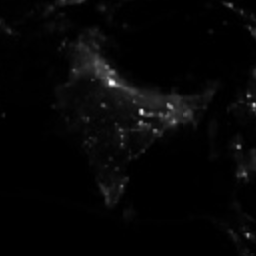
- Dostępność zbioru danych
- 2022-10-01T00:00:00Z–2025-12-11T12:00:00Z
- Dostawca zbioru danych
- NASA / GMAO
- Tagi
Opis
Ten zbiór danych zawiera prognozę meteorologiczną (fcst) danych o wysokiej częstotliwości czasowej (htf). Użyj właściwości „creation_time” i „forecast_time”, aby wybrać interesujące Cię dane. Goddard Earth Observing System Composition Forecast (GEOS-CF) to system prognozowania globalnych składników o wysokiej rozdzielczości (0,25°) opracowany przez Global Modeling and Assimilation Office (GMAO) w NASA.
GEOS-CF to nowe narzędzie do badania chemii atmosfery, które uzupełnia szeroki zakres obserwacji prowadzonych przez NASA z poziomu kosmosu i na miejscu. GEOS-CF rozszerza system modelowania pogody i aerozoli GEOS o moduł chemiczny GEOS-Chem, aby dostarczać prognozy wsteczne i 5-dniowe prognozy składników atmosfery, takich jak ozon (O3), tlenek węgla (CO), tlenek azotu (NO2), dwutlenek siarki (SO2) i pył zawieszony (PM2,5). Moduł chemiczny zintegrowany z GEOS-CF jest identyczny z modelem offline GEOS-Chem i korzysta z innowacji udostępnianych przez społeczność GEOS-Chem.
Ocena modelu GEOS-CF na podstawie danych satelitarnych, ozonosondowych i powierzchniowych z lat 2018–2019 wykazała realistyczne symulowane stężenia O3, NO2 i CO, ze znormalizowanymi średnimi odchyleniami od −0,1 do 0,3, znormalizowanymi błędami średniokwadratowymi w zakresie 0,1–0,4 i korelacjami od 0,3 do 0,8. Porównania z obserwacjami powierzchniowymi pokazują, że w wielu regionach świata i we wszystkich porach roku udało się dobrze odwzorować zanieczyszczenia powietrza, ale też wskazują na obecne ograniczenia, takie jak globalne zawyżanie SO2 i zbyt wysokie prognozowanie O3 w okresie letnim w południowo-wschodniej części Stanów Zjednoczonych.
Wersja GEOS-CF 1.0 zawyża zwykle stężenie aerozoli o 20–50% z powodu znanych problemów w wersji GEOS-Chem 12.0.1, które zostały rozwiązane w późniejszych wersjach. Prognozy 5-dniowe mają wyniki porównywalne z prognozami 1-dniowymi. Umiejętności modelu można znacznie poprawić, stosując korektę odchyleń do danych wyjściowych modelu powierzchniowego za pomocą uczenia maszynowego.
Pasma
Rozmiar piksela
27 750 metrów
Pasma
| Nazwa | Jednostki | Rozmiar piksela | Opis |
|---|---|---|---|
CO |
Ułamek molowy | metry | Stosunek objętościowy tlenku węgla (CO, MW = 28,00 g mol-1) w suchym powietrzu |
NO2 |
Ułamek molowy | metry | Stosunek objętościowy dwutlenku azotu (NO2, MW = 46,00 g mol-1) w suchym powietrzu |
O3 |
Ułamek molowy | metry | Stosunek objętościowy ozonu (O3, MW = 48,00 g mol-1) w suchym powietrzu |
PM25_RH35_GCC |
ug m-3 | metry | Pył zawieszony o średnicy poniżej 2,5 µm przy wilgotności względnej 35% |
PM25_RH35_GOCART |
kg/m³ | metry | Całkowity zrekonstruowany poziom PM2,5 przy wilgotności względnej 35% |
Q |
Ułamek masowy | metry | Wilgotność właściwa |
RH |
metry | Wilgotność względna po nasyceniu |
|
SLP |
Pa | metry | Ciśnienie na poziomie morza |
SO2 |
Ułamek molowy | metry | Stosunek objętościowy dwutlenku siarki (SO2, MW = 64,00 g mol-1) w suchym powietrzu |
T |
K | metry | temperatura powietrza, |
U |
m/s | metry | Wiatr wschodni |
V |
m/s | metry | Wiatr północny |
Właściwości obrazu
Właściwości obrazu
| Nazwa | Typ | Opis |
|---|---|---|
| creation_time | LICZBA ZMIENNOPRZECINKOWA O PODWÓJNEJ PRECYZJI | Czas utworzenia |
| forecast_time | LICZBA ZMIENNOPRZECINKOWA O PODWÓJNEJ PRECYZJI | Czas prognozy |
Warunki korzystania z usługi
Warunki usługi
O ile nie zaznaczono inaczej, wszystkie dane wygenerowane przez NASA mogą być używane w dowolnym celu bez wcześniejszego zezwolenia. Więcej informacji i wyjątki znajdziesz na stronie NASA z zasadami dotyczącymi danych i informacji.
Cytaty
Keller, C. A., Knowland, K. E., Duncan, B. N., Liu, J., Anderson, D. C., Das, S., ... & Pawson, S. (2021). Opis systemu modelowania prognozy składu atmosfery NASA GEOS GEOS-CF w wersji 1. 0. Journal of Advances in Modeling Earth Systems, 13(4), e2020MS002413. doi:10.1029/2020MS002413
DOI
Odkrywanie za pomocą Earth Engine
Edytor kodu (JavaScript)
var imageVisParamNO2 = { 'bands': ['NO2'], 'min': 6.96e-11, 'max': 4.42e-8, }; var imageVisParamT = { 'bands': ['T'], 'min': 220, 'max': 320, 'palette': ['d7191c', 'fdae61', 'ffffbf', 'abd9e9', '2c7bb6'], }; var geosCf = ee.ImageCollection('NASA/GEOS-CF/v1/fcst/htf'); Map.setCenter(100, 20, 3); var weeklyT = geosCf.select('T').filterDate('2022-11-01', '2022-11-08').median(); Map.addLayer(weeklyT, imageVisParamT, 'Weekly T', false, 1); var NO2 = ee.Image('NASA/GEOS-CF/v1/fcst/htf/20221215_12z-20221216_1200z'); Map.addLayer(NO2, imageVisParamNO2, 'NO2', true, 1);
